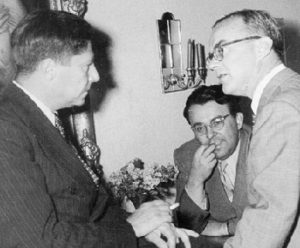Étiquette : Irving Brown
The Congress for Cultural Freedom: How the CIA « weaponized » Modern Art
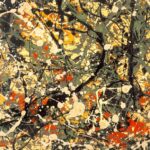
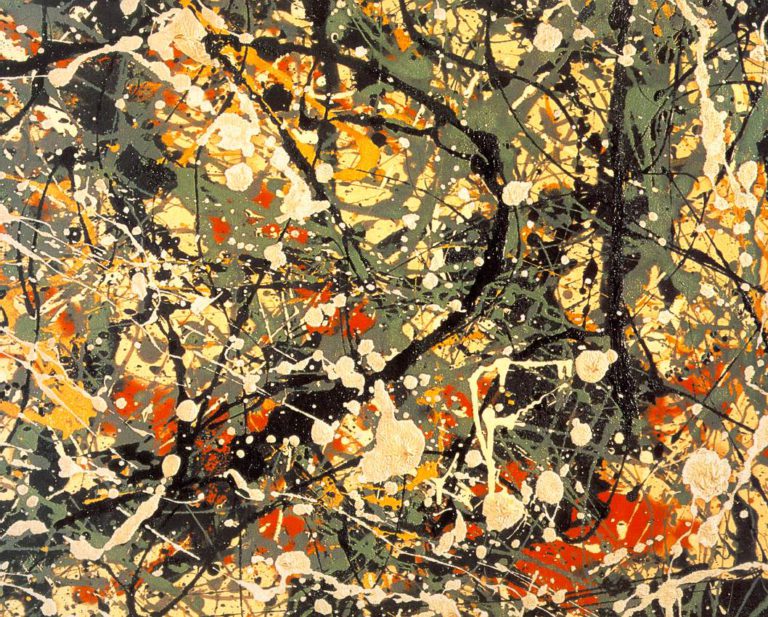
This article, first published in 2006, came as a book review of the book Who Paid the Piper of British researcher Frances Stonor Saunder, published in French Article under the title Qui mène la danse? La CIA et la guerre froide culturelle, 506 pages, Editions Denoël, Paris, 2003.
This book, which caused a stir in Germany, England and the Hispanic world, is literally appalling. Not only for what it reveals, but above all for what it leaves unsaid.
After years of meticulous research, interviews and archival work, the young writer Frances Stonor Saunders, producer of historical documentaries for the BBC, delivers an uncompromising account of the Anglo-American cultural Cold War against the Soviet Union from 1947 onwards.
Congress for Cultural Freedom
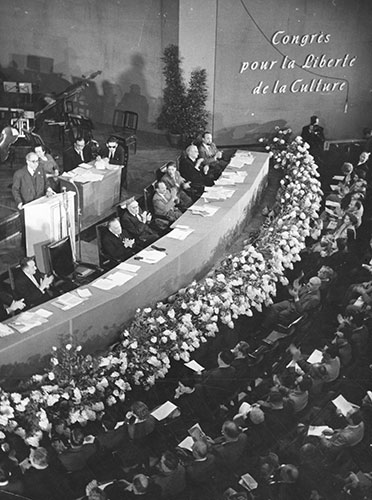
At the heart of this secret « Kulturkampf », a veritable cultural Cold War, was the Paris-based Congress for Cultural Freedom (CCF), headed from 1950 to 1967 by CIA agent Michael Josselson.
Josselson, who spoke four languages, along with music composer Nicholas Nabokov, was a former member of the psychological warfare division of the Office for Strategic Services (OSS), which US President Harry Truman replaced with the CIA in 1945.
The first thing that strikes the reader is the analogy between the language of the Cold War and the narrative of today’s war hawks to justify a new crusade « against terrorism. »
Back then, under the guise of a merciless struggle against the horrors of Stalinism, the Anglo-American imperial faction deployed whole swathes of the CIA in an attempt to impose Bertrand Russell‘s utopian vision of « world government. »

The CIA described itself as an « Order of Knights Templar » charged with « saving Western freedom from Communist darkness ». Its principal theoretician was George Kennan, Director of the Policy Planning Staff at the State Department.
Like the « Noble Lies » employed today by the neo-conservatives, followers of Leo Strauss, Kennan asserted in 1947 that the Communists had gained a position of prominence in Europe,
« through the shameless and skillful use of lies. They fought us with the weapon of unreality and irrationalism. Can we triumph over this unreality with rationalism, truth, honest and well-intentioned economic assistance? »
Obviously not! And the most formidable weapon for world domination will be, as always: the soft power of « culture ».
Indeed, « you can’t be a great power if you don’t have the art to go with it, it’s like Venice without Tintoretto or Florence without Giotto ».
So, ironically, while American public opinion was held hostage by the McCarthyite psychosis for whom « all modern art is communist », to the point of suspecting certain abstract paintings of indicating the exact location of American military bases (sic), the oligarchs saw in « lyrical abstract » expressionism the virtues of a specifically anti-communist ideology.
By a simple logic of inversion, everything that Nazis and Stalinists considered « degenerate art » automatically became emblematic of the values of freedom and free enterprise, and therefore got massively financed… in the greatest secrecy.
With a wealth of detail, the author documents the mesh of this operation over some five hundred pages. It is, of course, impossible to summarize here the descriptions of the lives of dozens of men, women, musicians, authors, magazines, networks and foundations, each page of which delivers a few pearls.
Some of the details shed a special light on contemporary French history.
The CIA in Paris
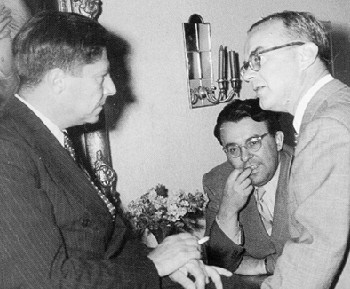
In Paris, it was Irving Brown (1911-1989), a representative of the powerful AFL-CIO union (with free access to secret Marshall Plan funds), who offered the CCF in Paris a suite in the Hôtel Baltimore on Avenue Kléber to set up its temporary headquarters, before paying the rent for a permanent office on Boulevard Haussmann.
On behalf of his boss Jay Lovestone (1897-1990), himself a helper of the CIA’s James Jesus Angleton, Irving Brown financed anything that might weaken France’s resistance to the utopia of world government, i.e. anything that might harm Gaullism and, to a certain extent, Communism.
Josselson and his wife met him quite often in a gay bar, « L’Indifférent ». One evening, they find him handing over a large sum of money to a Marseille mobster. A fan of the big boys, Brown was heavily involved in anything that could reduce the influence of the Communists.
It was from that perspective that he helped former members of the Vichy government, as well as Trotskyites. He controlled French ports, broke strikes and financed the new Force Ouvrière union to split the CGT communist union, all the while promoting modern art!*
Alongside Irving Brown, the CCF board included Michael Josselson, Lawrence de Neufville (his CIA recruiter, later appointed to Radio Free Europe), Arthur Koestler, Melvin Lasky, former Trotskyist James Burnham, as well as Carlo Schmid of the German SPD, Haakon Lie, leader of the Norwegian Labour Party, and David Rousset of the French Parti Socialiste.
In his book The Machiavellians, Burnham used Machiavelli to « challenge egalitarian political theory and show the persistence and inescapability of the elite, even in an age of equality ».
In 1953, Burnham played a crucial role in the CIA’s Operation AJAX, which overthrew Dr. Mossadegh in Teheran and replaced him with the Shah.
Later, « more presentable » funding sources than Irving Brown came into play: CIA front organizations such as the Farfield Foundation, headed by Julius Fleischman, or the Hoblitzelle Foundation, but also classics like the Ford, Carnegie or Rockefeller brothers’ foundations.
Thanks to these generous donors, the CCF made millions of dollars available to literary magazines such as
- Encounter, edited by former Trotskyite Irving Kristol (father of current neo-conservative William Kristol) in London;
- Preuves, edited in Paris by François Bondy of the European Union of Federalists;
- Der Monat, edited by Melvin Lasky in Berlin;
- Tempo Presente, edited by Ignazio Silone in Rome;
- Soviet Survey, edited in Israel by historian Walter Laqueur.
After the OSS’s (reciprocal) expressions of sympathy for Hemingway or Antoine de Saint-Exupéry, these magazines opened their columns to authors such as Jorge-Louis Borges, Raymond Aron, Arnold Toynbee, Bertrand Russell, Arthur Schlesinger Jr., Herbert Read or Hugh Trevor-Roper, or contributed to the publication of their writings.
In 1950, the CIA commissioned the production of a cartoon based on George Orwell’s Animal Farm (real name Eric Blair).
Also in Paris, CIA man Peter Matthiessen helped found the Paris Review run by John Train, a far-right liberal New York billionaire.
CIA Culture

Destruction of the well tempered music
The CCF also financed major musical events to promote « modern » twelve-tone serialism (dodecaphony), such as the April 1952 festival organized by Nicolas Nabokov in Paris.
Nabokov believed that « dodecaphony abolishes natural hierarchies » and allows us to free ourselves from the internal logic of music.
Anne C. Shreffler argues that the « compositional avant-garde » was politicized more by its advocacy of personal freedom than by political influence. Shreffler goes on to argue that both the Soviet Union and the United States sent out messages that dealt with « freedom. » However, Western Europe and the United States claimed a « moral high ground » in the struggle for individual freedom, a high ground that made certain artistic aesthetics (e.g., cubism, surrealism, dodecaphony, and existentialism) almost « obligatory » for artists.
The promotion of « liberated » music as a counterpoint to « Social Realism« , which essentially « marginalized » the populist Soviet musical aesthetic, was explicitly a politically calculated move by the Congress for Cultural Freedom.
The festival opened with « The Rite of Spring » of Igor Stravinsky, new convert to twelve-tone dodecaphonic system.
Among the participants from the USA: Leontyne Price, Aaron Copland, Samuel Barber, the New York City Ballet (Balanchine‘s troupe), the Boston Symphony Orchestra, the New York Museum of Modern Art (MoMA), James T. Farrell, W.H. Auden and Gertrude Stein.
European participants included Jean Cocteau, William Walton, Laurence Olivier, Benjamin Britten, the Vienna Opera, Covent Garden Opera, Czeslaw Milosz, Denis de Rougemont and Guido Piovene, to name but a few.
Appointed Eisenhower’s special advisor on Cold War strategy, American Vice-President Nelson Rockefeller played a fundamental role in promoting the CIA’s modernist painting. Supporting left-wing artists practicing abstract expressionism was commonplace for the Rockefellers.
Nelson’s mother, Abby Aldrich Rockefeller, had founded the Museum of Modern Art in New York – the Modern Art Museum (MoMA) – asserting that reds would stop being reds « if we gave them artistic recognition ». Several MoMA trustees were also trustees of the Farfield Foundation, as indicated, a CIA front.
As Donald Jameson of the CIA put it:
« We understood that this was the kind of art that has nothing to do with social realism and makes it even more stylized, rigid and confined than it was. »
MoMA bought works by Diego Riviera, Jackson Pollock, Arshile Gorky, Alexander Calder, Robert Motherwell, Stuart Davis, Edward Hopper and others.
By attributing the « success » of an impressive number of contemporary cultural actors to the will of an imperial elite, motivated by a more than suspect ideological blindness and endowed, what’s more, with unparalleled financial resources and communication strategies, Stonor Saunders’ book immediately casts deep discredit on all post-war artistic creation.
Most of these « artists » were chosen because they conveyed an ideology deemed compatible with the totalitarian designs of the high priests of world order.
Only the reactionary Peregrine Worsthorne titles his book review of Saunders’ Who Paid the Piper, « How Western Culture was saved by the CIA », nostalgically lamenting the Machiavellian genius of the Anglo-American elite in its heyday.
Of course, some artists weren’t necessarily aware of the source of the funds, but they all expected them to fill their pockets… And perhaps most shockingly of all, the CIA took art more seriously than many citizens or critics of the time.
So, perhaps this survey does posthumous justice to all those talents sacrificed on the altar of illusory power. Think of all those crushed hopes, sabotaged careers and stifled seeds of genius. For in this delirious tournament of the Cold War, the great priesthood ruling over the art world would only saddle those willing to bend the knee, while with a wave of the hand, send others to the deadly silence of oblivion.
NOTE:
*In his book Les Trotskistes (Fayard, 2002), Christophe Nick states, with regard to the non-communist student union UNEF, that at one time, « thanks to Irwing Brown‘s good offices, the U.S. Embassy was able to cover the student union’s end-of-month budgets ».
In Secrets de famille (Fayard, Paris 2001), Serge Raffy reveals that « Lionel Jospin, then First Secretary of the Socialist Party, met in Washington on April 14, 1982 with leaders of the American AFL-CIO union to reassure them that the Mauroy government would include Communist ministers. The man who organized the meeting was a CIA agent, Irving Brown, the same man who founded and financed the French trade union Force Ouvrière to combat the Communist CGT financed by Soviet Russia. Irving Brown is also said to have constantly maintained links between the Trotskyites, and in particular the OCI, and FO. »
On the right, the student union, Union Inter-Universitaire (UNI), which made the career of so many politicians on the right, was also backed by CIA agent of influence Irving Brown and received $575,000 between April 1984 and April 1985 from the government of the United States through the National Endowment for Democracy.
L’Art moderne de la CIA pour combattre le communisme
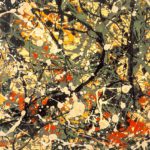
Article initialement publié le 8 août 2003 lors de la parution du livre Qui mène la danse ? La CIA et la guerre froide culturelle (Titre original : Who Paid the Piper, Frances Stonor Saunders), 506 pages, Editions Denoël, Paris, 2003, 24,50 euros.
Ce livre, qui fait grand bruit en Allemagne, en Angleterre et dans le monde hispanique, est littéralement effroyable. Par ce qu’il révèle, d’une part, mais surtout par les non-dits qu’il laisse transparaître. Après des années de recherche minutieuse, d’interviews et de travail d’archive, la jeune écrivain Frances Stonor Saunders, productrice de documentaires historiques pour la BBC, nous livre sans concession sa vaste enquête sur le bras de fer culturel auquel se livrèrent dès 1947 les Etats-Unis et l’Union soviétique.
Au coeur de ce « Kulturkampf » secret, véritable guerre froide culturelle, se trouve le « Congress of Cultural Freedom » (CCF, Congrès pour la liberté de la culture), basé à Paris et dirigé de 1950 à 1967 par l’agent de la CIA Michael Josselson.
Ce dernier, qui parlait quatre langues, avait appartenu, avec le compositeur de musique Nicholas Nabokov, à la division de guerre psychologique de l’Office for Strategic Services (OSS), que Truman remplaça par la CIA en 1945.
- La première chose qui frappe le lecteur, ce sont les analogies entre le langage de la guerre froide et les diatribes des faucons actuels, servant à justifier une nouvelle croisade contre le terrorisme. A l’époque, sous couvert d’une lutte sans merci contre les horreurs du stalinisme, la faction impériale anglo-américaine déploya des pans entiers de la CIA pour tenter d’imposer l’utopie d’un gouvernement mondial, prôné par Bertrand Russell.
La CIA se décrivait elle-même comme un « ordre de Templiers » chargé de « sauver la liberté occidentale des ténèbres communistes ». Son principal théoricien était George Kennan, directeur du Policy Planning Staff au Département d’Etat.
- A l’instar des « nobles mensonges » employés aujourd’hui par les faucons, adeptes de Léo Strauss, Kennan affirmait en 1947 que les communistes avaient acquis une position d’envergure en Europe « grâce à l’utilisation habile et sans vergogne de mensonges. Ils nous ont combattus avec l’arme de l’irréalité et de l’irrationalisme. Pouvons-nous triompher de cette irréalité par le rationalisme, la vérité, une assistance économique honnête et bien intentionnée ? »
- Évidemment non ! Et l’arme la plus redoutable pour dominer le monde sera, comme toujours, la culture.
En effet « on ne peut pas être une grande puissance si l’on n’a pas l’art qui va avec, c’est comme Venise sans le Tintoret ou Florence sans Giotto ».
Alors, ironiquement, tandis que l’opinion publique américaine est prise en otage par la psychose maccarthyste, pour qui « tout art moderne est communisant », au point de soupçonner certains tableaux abstraits d’indiquer l’emplacement exact des bases militaires américaines (sic), les oligarques voient dans l’expressionnisme abstrait les vertus d’une idéologie spécifiquement anticommuniste. Par une simple logique d’inversion, tout ce que nazis et staliniens considèrent comme un « art dégénéré » devient automatiquement emblématique des valeurs de liberté et de libre entreprise, et donc massivement financé… dans le plus grand secret.
Avec une foultitude de détails, l’auteur documente sur quelque cinq cents pages le maillage de cette opération. Il est bien sûr impossible de résumer ici les descriptions de la vie de dizaines d’hommes, femmes, musiciens, auteurs, magazines, réseaux et fondations, dont chaque page nous livre quelques perles. Certains détails croustillants jettent un éclairage particulier nous permettant de mieux comprendre l’histoire française contemporaine.
La CIA à Paris
A Paris, c’est Irving Brown (1911-1989), représentant du puissant syndicat AFL-CIO (bénéficiant d’un libre accès aux fonds secrets du plan Marshall), qui offre au CCF une suite à l’hôtel Baltimore, avenue Kléber, pour y établir son QG provisoire, avant de lui payer le loyer d’un local permanent boulevard Haussmann.
Pour le compte de son patron à la CIA, Jay Lovestone (1897-1990), ennemi juré de Lyndon LaRouche, Irving Brown finance tout ce qui peut affaiblir la résistance de la France à l’utopie d’un gouvernement mondial, c’est-à-dire tout ce qui peut nuire au gaullisme et, dans une certaine mesure, au communisme.
Josselson et sa femme le rencontrent assez souvent dans un bar homosexuel, « l’Indifférent ». Un soir, ils le trouvent en train de remettre une forte somme d’argent à un « gangster de Marseille ». Amateur de gros bras, Brown s’était beaucoup investi dans tout ce qui pouvait réduire l’influence des communistes. Il aide des anciens de Vichy, mais aussi des trotskistes. Il contrôle les ports français, casse des grèves, finance le nouveau syndicat Force Ouvrière, tout en promouvant l’art moderne !*
- Dans le comité de direction du CCF figurent, aux côtés d’Irving Brown, Michael Josselson, Lawrence de Neufville (son recruteur à la CIA, nommé plus tard à Radio Free Europe), Arthur Koestler, Melvin Lasky, l’ancien trotskiste James Burnham ainsi que Carlo Schmid du SPD allemand, Haakon Lie, chef des travaillistes norvégiens, et David Rousset, du PS français.
Dans son livre Les Machiavéliens, Burnham utilise Machiavel pour « contester la théorie politique égalitaire et montrer la persistance et le caractère incontournable de l’élite, même en un âge d’égalité ».
En 1953, Burnham joua un rôle crucial dans l’opération AJAX de la CIA, qui renversa le Dr Mossadegh à Téhéran pour le remplacer par le Shah.
Plus tard, des sources de financement « plus présentables » qu’Irving Brown entrent en jeu : des organisations écrans de la CIA, comme la Fondation Farfield, dirigée par Julius Fleischman, ou la Fondation Hoblitzelle, mais aussi des classiques comme les fondations Ford, Carnegie ou celle des frères Rockefeller.
Grâce à ces généreux donateurs, le CCF va mettre des millions de dollars à la disposition de magazines littéraires comme Encounter, dirigé par l’ancien trotskiste Irving Kristol (le père de l’actuel néo-conservateur William Kristol), à Londres, Preuves, dirigé à Paris par François Bondy, de l’Union européenne des fédéralistes, Der Monat, dirigé par Melvin Lasky à Berlin, Tempo Presente, dirigé par Ignazio Silone à Rome, ou encore Soviet Survey, édité en Israël par l’historien Walter Laqueur.
Après les marques de sympathie (réciproques) de l’OSS pour Hemingway ou Antoine de Saint- Exupéry, ces revues ouvrent leurs colonnes à des auteurs comme Jorge-Louis Borges, Raymond Aron, Arnold Toynbee, Bertrand Russell, Arthur Schlesinger Jr., Herbert Read ou Hugh Trevor-Roper, ou contribuent à la publication de leurs écrits.
Par ailleurs, dès 1950, la CIA fait produire un dessin animé inspiré de « La Ferme des Animaux », de Georges Orwell (Eric Blair, de son vrai nom). Toujours à Paris, Peter Matthiessen, de la CIA, participe à la fondation de la Paris Review de John Train, un milliardaire new-yorkais libéral d’extrême droite que l’on retrouve dans les années 80 finançant une cellule spéciale de journalistes chargée de mener une campagne de calomnies contre LaRouche.
La culture de la CIA

Le CCF finance également des événements musicaux de premier plan destinés à promouvoir la musique moderne dodécaphonique, comme le festival d’avril 1952, organisé par Nabokov à Paris. Celui-ci pense que « le dodécaphonisme abolit les hiérarchies naturelles » et permet de s’affranchir de la logique interne de la musique. Le festival s’ouvre donc avec « Le Sacre du Printemps » d’Igor Stravinsky, nouvellement converti à la musique dodécaphonique.
Venus des Etats-Unis, Leontyne Price, Aaron Copland, Samuel Barber, le New York City Ballet (la troupe de Balanchine), l’Orchestre Symphonique de Boston, le Musée d’Art moderne de New York, James T. Farrell, W.H. Auden, Gertrude Stein, s’associent à ce festival.
D’Europe participent notamment Jean Cocteau, William Walton, Laurence Olivier, Benjamin Britten, l’Opéra de Vienne, l’Opéra de Covent Garden, Czeslaw Milosz, Denis de Rougemont et Guido Piovene, pour n’en citer que quelques-uns.
Nommé conseiller spécial d’Eisenhower pour la stratégie de guerre froide, le vice-président américain Nelson Rockefeller jouera un rôle fondamental dans la promotion de la peinture moderne. Soutenir des artistes de gauche pratiquant l’expressionnisme abstrait était chose fréquente pour les Rockefeller.
La mère de Nelson, Abby Aldrich Rockefeller, avait fondé le Musée d’art moderne de New York – le Modern Art Museum (MoMA) – affirmant que les rouges cesseraient d’être rouges « si nous leur offrons une reconnaissance artistique ». Plusieurs administrateurs du MoMA sont en même temps administrateurs de la Fondation Farfield, paravent de la CIA. Comme le disait Donald Jameson, de la CIA : « Nous avons compris que c’était le type d’art qui n’a rien à voir avec le réalisme social et le rend encore plus stylisé, plus rigide et plus confiné qu’il ne l’était. » Le MoMA achète des oeuvres de Diego Riviera, Jackson Pollock, Arshile Gorky, Alexander Calder, Robert Motherwell, Stuart Davis, Edward Hopper, etc.
En attribuant ce « succès » d’un nombre impressionnant d’acteurs culturels contemporains à la volonté d’une élite impériale, motivée par un aveuglement idéologique plus que suspect et dotée, de surcroît, de moyens financiers et de stratégies de communication hors pair, le livre de Stonor Saunders jette d’emblée un profond discrédit sur toute la création artistique d’après-guerre. La plupart de ces « artistes » furent choisis parce qu’ils véhiculaient une idéologie jugée compatible avec le dessein totalitaire des grands prêtres de l’ordre mondial.
Il n’y a guère que le très réactionnaire Peregrine Worsthorne pour titrer sa critique du livre : « How Western Culture was saved by the CIA » (Comment la culture occidentale fut sauvée par la CIA), où il regrette avec nostalgie le génie machiavélique de l’élite anglo-américaine des grands jours. Bien sûr, certains artistes n’étaient pas forcément au courant de l’origine des fonds, mais tous s’attendaient à les voir couler à flots… D’ailleurs, et c’est peut-être le plus choquant, la CIA prenait l’art plus au sérieux que beaucoup de citoyens ou de critiques de l’époque.
Ainsi, cette enquête rend peut-être une justice posthume à tous les talents sacrifiés sur l’autel d’un pouvoir illusoire. Pensez à toutes ces espérances broyées, aux carrières sabotées et aux germes de génie étouffés. Car dans ce tournoi délirant de la guerre froide, les grands seigneurs ne mettent en selle que des chevaliers disposés à fléchir le genou, tandis que d’un revers de la main, ils renvoient les autres au silence mortel des oubliettes.
Notes :
*Dans son livre Les Trotskistes (Fayard, 2002), Christophe Nick affirme à propos du syndicat étudiant non-communiste, l’UNEF, qu’à une époque, « Grâce aux bons offices d’Irwing Brown, l’ambassade des Etats-Unis boucle les budgets de fin de mois du syndicat étudiant ».
Dans Secrets de famille (Fayard, Paris 2001), Serge Raffy révèle que « Lionel Jospin, alors premier secrétaire du Parti socialiste, rencontre à Washington le 14 avril 1982 les responsables du syndicat américain AFL-CIO afin de les rassurer sur la présence de ministres communistes dans le gouvernement Mauroy. Celui qui a organisé la réunion est un agent de la CIA, Irving Brown, celui qui a fait fonder et financer le syndicat français Force Ouvrière pour lutter contre la CGT communiste financée par la Russie soviétique. Le sieur Irving Brown serait également celui qui aurait constamment entretenu des liens entre les trotskistes, et notamment l’OCI, et FO. »
Confirmant toute la complexité du personnage, le réseau Voltaire, pour sa part, croit savoir qu’Irving Brown co-finança la création du FN avec Jacques Foccart.


